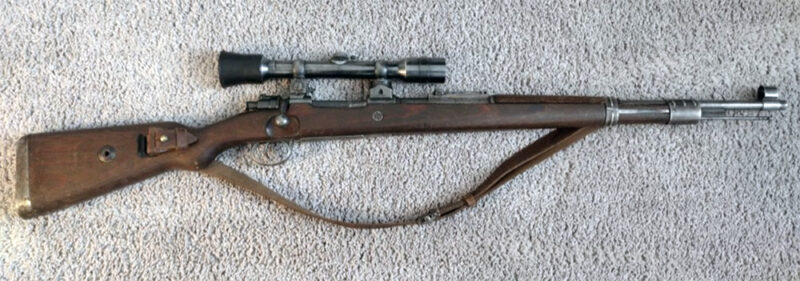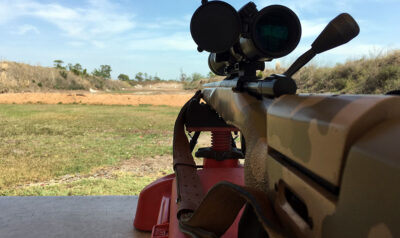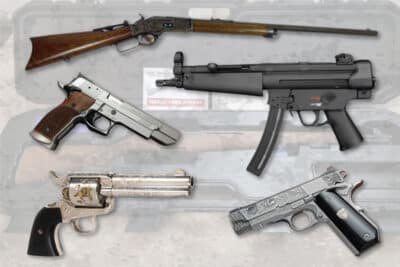Barrel Bargains: Finding Deals on Military Surplus Rifles
By Will Dabbs

I have been haunting GunBroker looking for sweet deals for decades. It is like a coast-to-coast gun show that runs 24/7. You can find literally anything among its hallowed digital pages if you look long enough.
After countless hours spent browsing, with over 100 guns purchased, I have learned a few things. If you’re in a hurry, you can get anything…for a price. However, if you are patient and stalk your prey, you can often land military surplus rifle deals at a seriously nice price. The secret is to be methodical and know exactly what you’re looking for.
The first step is to develop a refined appreciation for pre-owned firearms. I personally prefer a gun with a little mileage over something that seems too pretty to shoot, as used rifles tell stories.
A detailed assessment of the narrative and photos combined with a note or two to the owner will usually provide a good idea as to the actual condition despite not being able to paw over the gun face-to-face. Once you have your head around the particulars and have done a sober checkbook recon, that’s when the real fun begins.
9 Military Surplus Rifle Deals
German Kar98k

Designed in 1934, some 14,600,000 copies rolled off the lines before production ceased with the end of World War II. With that many guns in circulation, it was inevitable that a significant number might make it across the pond into the American market. Untold thousands of these rifles came home in duffle bags or were imported from surplus stocks.
Pristine examples will command pristine prices. However, I landed a Russian capture 98k that looks like it was stored in a cave someplace for a very reasonable price. The battle scars give the old girl character, and the gun’s age and condition mean I don’t fret about running corrosive ammo through it. If you haven’t killed a lazy Saturday afternoon at the range behind a vintage bolt-action service rifle, you are missing out. Burning a few rounds of surplus ammo through a WWII-vintage combat rifle will transport you to a different time.
German G43

The Germans knew at the outset of WWII that their infantry rifles were outclassed. For reasons I have never understood, the High Command insisted that their next-generation semi-auto battle rifle not have any holes drilled in the barrel. Ruling out traditional gas operation left the contenders unreliable and unsuited to combat on the Eastern Front.
After encountering the Russian SVT autoloaders on the battlefield, German gun designers were unleashed to build a rifle however they wished. The end result was the G43. This 7.92x57mm rifle was Germany’s answer to the M1 Garand.
The G43 was fairly effective, but it was never considered quite as robust as competing designs. However, half a million copies were built and it saw widespread service. The scoped version was quite the effective Designated Marksman Rifle.
Surplus G43s are invariably spendy. Straight rifle versions typically run three grand or so. Nice sniper rigs are two to three times that. However, I bought mine from a guy who was ready to rid himself of it at an excellent price. As always, success comes to the persistent.
Mosin-Nagant M1891

The Mosin-Nagant M1891 was designed in, you guessed it, 1891 in response to lessons learned during the 1877 Russo-Turkish War. Despite being lyrically obsolete by the 1930s, this venerable old communist rifle was used throughout WWII. There is even pictorial evidence of the Mosin-Nagant still being issued to unfortunate Russian dogfaces deployed to combat in Ukraine even today. A whopping 37 million were produced.
Cherry examples seem to be running around $600. However, seek out No Reserve auctions and follow them closely and you can find some used rifle deals. These old vintage guns are essentially unkillable. Additionally, there is a thriving subculture that orbits around producing aftermarket stocks and accessories to make your 100-year-old Mosin look like something out of Call of Duty: Modern Warfare.
Japanese Type 99

Right, wrong or otherwise, Japanese military rifles are typically not viewed with the same enthusiasm as are many other WWII combatant nation’s guns. However, a study after the war conducted by the NRA comparing the sundry bolt-action infantry arms showed the Type 99 to be the strongest of the lot. Quality ranges from superb for early war examples all the way through utter garbage for the last ditch 1945 versions. However, the crude nature of these late-war guns actually makes them appealing to purists like me.
Early examples sported a complex ladder anti-aircraft sight and a weird folding monopod. Late-war versions had a fixed rear peep sight and a wooden buttplate held in place with three carpenter’s nails. The particulars—whether the Mum marking is ground off of the receiver and what sort of shape the gun’s in—typically drive the price. High-end paratrooper versions will set you back several thousand dollars. Last ditch beaters from a seller who’s hungry can be found for a few hundred, if you’re patient.
British Lee-Enfield

The earliest versions of the Lee-Enfield bolt-action rifle first entered service with Her Majesty’s armed forces in 1895. The rifle soldiered on in various guises until 1957 when it was replaced by the L1A1 Self-Loading Rifle version of the FN FAL. The SMLE (Short Magazine Lee-Enfield) was the primary British service rifle during WWI. The subsequent simplified No. 4 served through WWII, though the SMLE was still a common fixture.
The Lee-Enfield can be charged from the top via stripper clips or from the bottom by means of a removeable box magazine. The Lee-Enfield action is recognized as the fastest military bolt gun ever produced. The standing record was set in 1914 by British Sergeant Instructor Alfred Snoxall. SGT Snoxall landed 38 rounds in a 12-inch target at 300 yards in 60 seconds.
Beater versions can be found on the site for around $500. No. 4 Mk I (T) sniper guns go for thousands. I landed a pristine unfired No. 4 Mk I (T) several years ago at an insanely low price relative to what the gun was actually worth. That brings up another interesting point.
Sometimes good used rifle deals still cost a lot of money. A cheap Rolls Royce is still expensive. However, the $1,200 I dropped on that gorgeous Lee-Enfield sniper rifle represents one of the best military surplus gun investments I have ever made. It pays to be patient and take your time.
M1 Garand

John Cantius Garand was a French-Canadian who designed his first serious combat rifle in 1924. Seven years later, the experimental T1E2 was christened the “Semiautomatic Rifle, Caliber 30, M1.” We call it the Garand today. Veteran buddies who served in WWII always just called it the M1.
Just shy of 5.5 million were built, and this indestructible semi-auto rifle became an American icon. As a result, they are a common fixture on the modern military surplus market. The Civilian Marksmanship Program still sells M1s to civilian shooters today. Back in the 80s, these guns were sold through the CMP for $165. I paid around $500 for mine several decades ago.
I just punched it up and got 369 hits. Expect to pay $1,500 or so for a rack-grade Springfield Armory example. Weird versions or sniper variants are considerably more expensive. I found one “Buy Now” at $1,400. Every decent military firearm collection needs at least one copy.
M1 Carbine

There is an Internet-based church that orbits around carbine collecting. Bodged together in 13 days by a group of engineers at Winchester in the early days of WWII, the M1 carbine ultimately became the most-produced American rifle of the war, with 6.5 million copies made. At the apogee of production, companies were rolling out 65,000 new guns per day.
There were 10 major manufacturers, and the rifle underwent a major upgrade late in the war. Landing an original gun with early features is a grail-like quest for the gun nerd committed to his craft. However, beware—spare parts abound. The world is covered in a thin patina of fakes.
I have an all-original early carbine made by the Rock-Ola jukebox company, as well as a vintage first-run M1A1 paratrooper carbine. Both of these admittedly set me back a pretty penny. However, I also have a blaster-grade Postal Meter parts gun with a blued civilian barrel that I landed for around $600 and can shoot without guilt. There are currently some 1,200 examples for sale on GunBroker. Buried someplace in all of that clutter are some great used rifle deals.
M1903 Springfield

The Garands and carbines got all of the press, but U.S. dogfaces trained with and used bolt-action Springfield rifles all the way to the end of the WWII. Developed early in the 20th Century, this WWI warhorse evolved through scads of variants. However, there are two major versions.
The basic M1903 helped the Allies win the War to End All Wars. The subsequent M1903A3 was developed in 1942 and featured a redesigned sighting system and certain modifications to make the gun more easily produced.
As is always the case, the price is driven by the details. A basic service rifle might set you back $900 or so. A vintage perfect sniper gun will be many times more. The M1903 sniper featured prominently in the Stephen Spielberg war epic Saving Private Ryan. If nothing else, that gives the old girl character.
Italian M91 Carcano

There are scads of different subtypes of the basic Carcano. Lee Harvey Oswald apparently used one to shoot JFK back in 1963. However, the Carcano is the unwanted stepchild of the surplus rifle world. That means they can still be found at a very good price.
A quick perusal of the site shows a Carcano M91 bolt-action carbine with a folding bayonet for sale with a “Buy It Now” price of $278. Ammo is expensive, and you won’t be winning any 1000-yard matches with such a beast. However, it is still a WWII-vintage service rifle that has been-there done-that at a 1980s price.
Looking for More Military Surplus Deals?






![The New Tikka ACE Rifles [Video]](https://qacontent.gunbroker.com/wp-content/uploads/2025/02/Tikka-Featured-SHOT-2025-400x267.png)